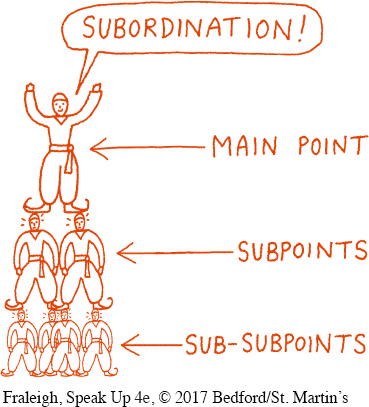Subordination and Coordination
The principle of subordination is the key to a well-
Sound confusing? It isn’t, really. To see how subordination and coordination work, compare the subpoints (indicated by capital letters) supporting each main point (signaled by roman numerals) in the following outline for an informative speech on filmmaking in India:
Culture plays an important role in Indian filmmaking.
Indian moviemakers developed a style of their own by the 1950s, based on the teachings of Natya Shastra (Science of Theater), a thousand-
year- old Hindu book. Entertainment was to embody nine essences— love, hate, sorrow, disgust, joy, compassion, pity, pride, and courage.3 According to Professor Murthy and colleagues in journalism and mass communication at Tezpur University, “The common core areas that one should know to understand and interpret Indian cinema are as follows: (1) celebrated epics . . . , (2) classical dance traditions . . . , and (3) the traditional folk theaters.”4
Page 260

There are differences between Indian-
made films and films made in the United States. In India, films need not follow the linear, scripted story line that is popular in Western movies. Of any hundred films made in India, about three will have scripts prepared in advance, according to screenwriter Anjum Rajabali.5
New York University anthropology professor Tejaswini Ganti notes that as Bollywood was becoming an internationally acknowledged brand, lip-
synched songs were a staple of Hindi films. Over time, the use of music has remained important, but lip- synched songs are no longer essential for a film to draw a large audience.6
Notice that both subpoints for main point I pertain to the subject of the main point—
To practice identifying main points and subpoints, try Video Activity 9.1, “Without Liberty and Justice for All.”
Page 261
